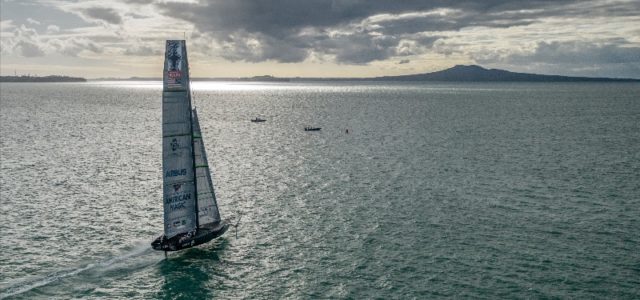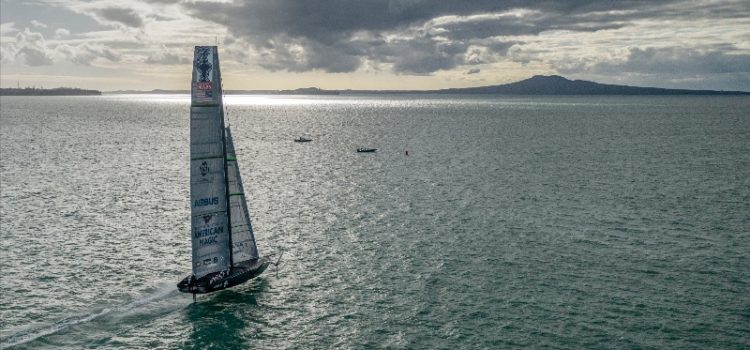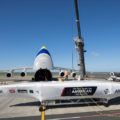

America’s Cup, Defiant is decommissioned: now American Magic sails on Patriot
America's CupAmerican MagicBreaking newsEnglishIn evidenzaVela 4 Ottobre 2020 Zerogradinord 0

Auckland – New York Yacht Club American Magic, the U.S. Challenger for the 36th America’s Cup, has decommissioned its first AC75, Defiant. The planned conclusion of Defiant’s testing lifecycle follows a stretch of sailing that began in September 2019 in Portsmouth, Rhode Island, continued on to Pensacola, Florida, and ended in Auckland after 12 months of hard testing and unprecedented performance.
Following Defiant’s decommissioning, the full attention and resources of the team have been directed towards the pre-launch preparations for its second AC75, Patriot.
“Defiant has been an absolutely perfect tool for us to use in the development process,” said Terry Hutchinson, Skipper and Executive Director of American Magic. “With every one of these programs you run through certain developmental phases. With this type of boat, with the foils and the sails and the hull forms and the systems inside the boat all being incredibly complicated, it’s been a great platform for us to learn on and to understand the strengths and weaknesses of our team.“
After becoming the first AC75 in the world to sail and foil in September 2019, Defiant sailed thousands of training miles in three widely separated venues while pouring valuable data into the team’s ongoing design process for Patriot. Never intended as a fully optimized racing yacht, Defiant had nevertheless been expected to compete in two European America’s Cup World Series regattas in Cagliari, Italy, and Portsmouth, U.K. in 2020 prior to their cancellation due to COVID-19.
“While we haven’t been able to do any racing against another boat, we have done plenty of race simulation laps now, while learning what you can and can’t do [in the AC75],” said American Magic helmsman Dean Barker. Barker also noted that thanks to superlative shore team efforts, Defiant’s last few weeks on the water in Auckland had been her most valuable.
“The thing with these boats is that they have to be 100% race-ready when you leave the dock or it’s almost impossible to sail,” said Barker. “I think we’ve been very lucky with the team that we’ve got, and the way they’ve kept the boat in one piece. We’ve managed to maintain a reasonable amount of reliability over the last few weeks in New Zealand. That’s allowed us to be a lot more productive on the water. At the same time, knowing PATRIOT was getting even closer to being in the water while we were still out learning what we could [on Defiant] has been really important.”
As he reflected on the end of Defiant’s planned lifecycle, American Magic Principal Designer Marcelino Botin noted that the design period prior to the launch of the team’s first AC75 was one of the most challenging of the campaign.
“Obviously [the AC75] was a new rule that had to be analyzed and looked at pretty carefully,” said Botin. “We decided to build [our first AC75] as soon as possible, and as soon as the rule permitted us to do. At the same time, we were also working on the Mule, our little test boat. So it was a pretty demanding time for the design office to be working on the two boats at the same time. Those were the requirements we had at the time, and those two boats really served us well.”
The AM38 test boat, nicknamed “the Mule” by Team Principal Roger Penske, amassed 92 days on the water, and Defiant followed with 66. American Magic’s combined number of training days represents a significant achievement to date by the design, production, shore and sailing teams, and underlines the team’s commitment to real-world data collection and analysis paired with advanced simulation.
With Patriot nearing her launch date in Auckland, Botin and said he was proud of the team’s disciplined approach, rapid progress, and how as a group they had risen to the design, production and sailing challenges the AC75 represents.
“Five or six years ago, you never would have thought that we’d see a monohull foiling and sailing at the speeds these boats do,” said Botin. “To me the most surprising thing has been how fast these boats can go, especially upwind. They are always surprising in that respect, just really impressive machines.




No comments so far.
Be first to leave comment below.